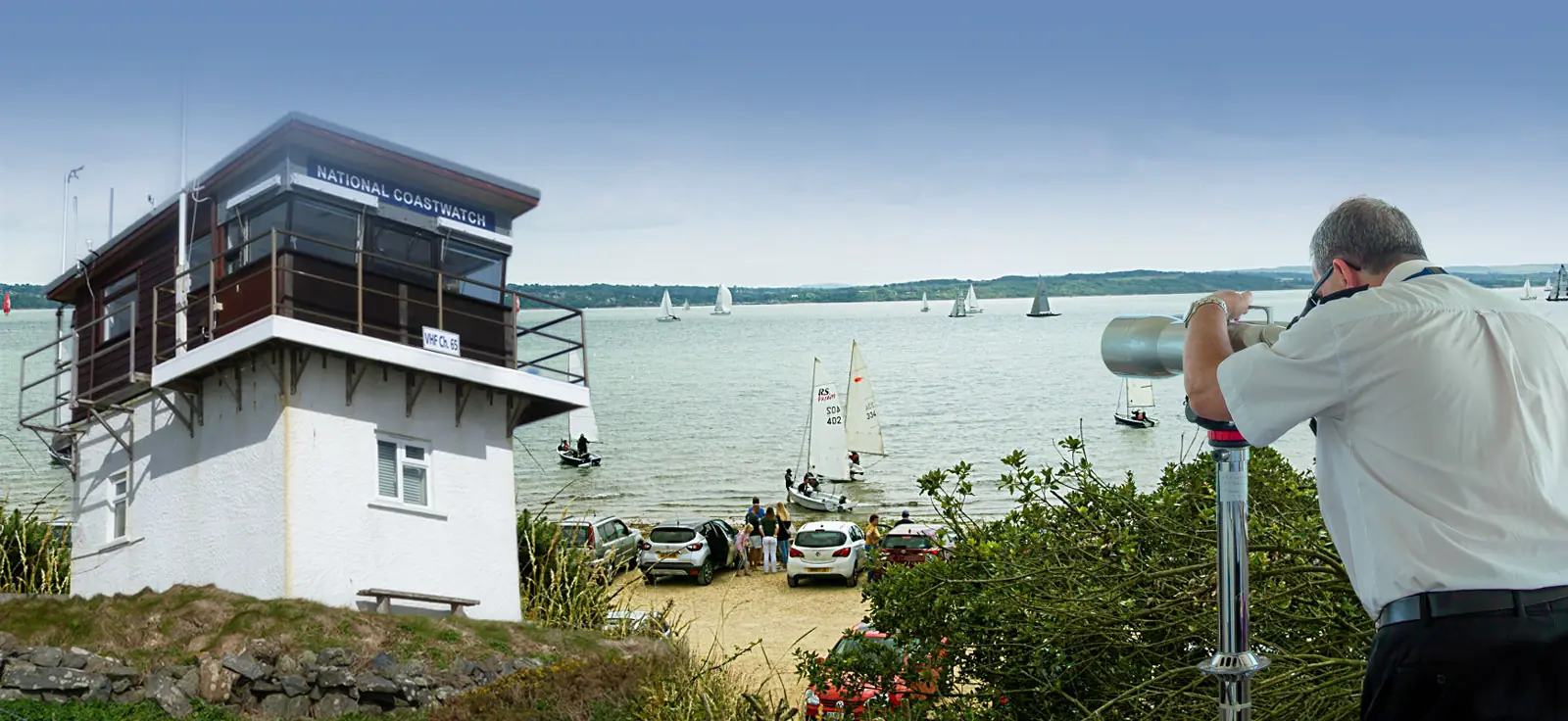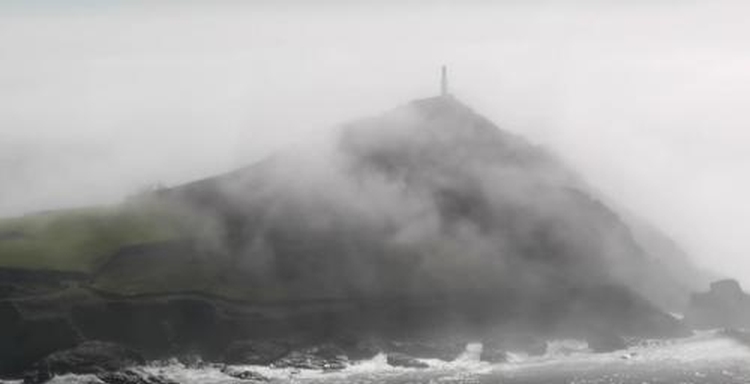
There are many tales associated with Cornwall; witches, magic, smugglers and wreckers. Some of these we take with a pinch of salt, others we ignore at our peril! Be that as it may, the Gwennap Head cliffs can be an eerie place, as mist creeps in from the sea and,perhaps, it is not wise to venture onto this lonely place. When there is also the low moaning of the nearby Runnel Stone buoy it adds a ghostly presence to the area. Indeed, the surroundings abound with tales of ghosts and evil doing, of smugglers and wreckers. Even today, if a ship goes aground or a container comes ashore, people are not slow to take the opportunity to avail themselves of the windfall. In February 2002 the ship Kodima foundered off the Cornish coast and its cargo of wooden planks was released to help with the refloating procedure……in 2003, there were brand new buildings springing up all over the southwest! However, be that as it may, the following tales serve to give a glimpse into the old Cornwall, the land of legend and mystery .
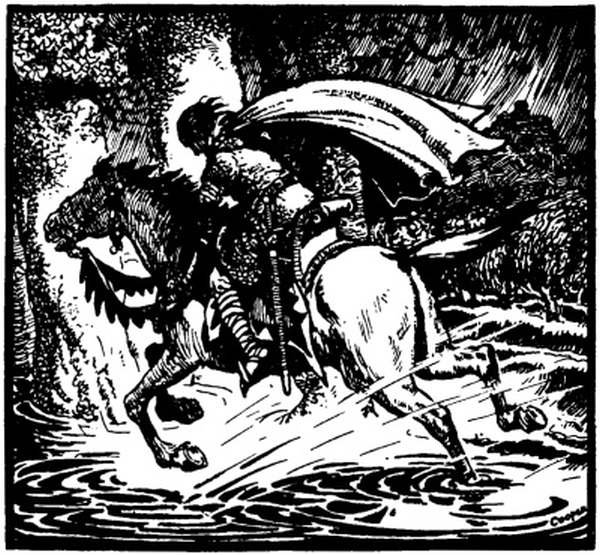
The Lost Land of Lyonesse: On a clear day, from Gwennap Head, the Isles of Scilly can be seen, some 28 miles away. It is said that they are the high peaks of the land of Lyonesse, described in legend as the site of Arthur’s final battle with his rival, Mordred. Those same legends say that the kingdom of Lyonesse sank beneath the waves, off the Cornish shore…..and, in the past, vegetation washed ashore in Mounts Bay has been suggested as supporting this idea. Indeed, there is much written and photographic evidence of sightings of tree stumps in the waters between Mounts Bay and Land’s End. Moreover, the storms of 2014 revealed trunks of pine and oak, as well as the remains of hazel thickets, with well-preserved cob nuts and acorns washed out by streams running across the beach. Intriguingly, the Cornish name for St Michael’s Mount which rises up from the bay is “Carrack Looz en Cooz” which translates as “the grey rock in the wood”! Did our ancestors know something that we’ve forgotten?
The Lost Land of Lyonesse was – they say – both fertile and prosperous, comprising rich, lush plains, and beautiful cities. A land peopled by a noble race, whom 140 church towers summoned to worship. However, the stories also say that Lyonesse was gradually invaded by the sea. Here a bit and there a bit would be submerged after some winter storm, until, on a grim November night in 1099, a mighty gale of unparalleled severity raged in the West. The storm was so destructive that it caused the sea to make a clean sweep of the country, rushing, with stupendous speed, across the flat wooded lands until it was brought to a halt by the massive cliffs of what is now the Land’s End peninsula.
All were lost…..except for Trevilian (or Trevelyan), an ancestor of the old Cornish family of that name, who only just escaped with his life from this deluge. He had foreseen what was coming, had wisely removed his farm stock and his family from his Lyonesse estate, and was making one further journey to his threatened home when the sea broke in upon it. Trevilian, mounted on his fleetest horse, just beat the waves, and, near Perranuthnoe, there is a cave which, they say, was the place of refuge to which the sturdy white horse galloped to safety, bringing his master through the angry waters. Coincidentally (?), the Vyvyans, for centuries, one of the most famous Cornish families in Penwith, still have as their family crest a white horse saddled, minus rider…perhaps, an artistic reminder of that famous white horse from Lyonesse? It’s also said that the Vyvyans keep a white horse in their stables at Trelowarren, saddled and waiting for any such crisis!
Despite our long tradition of this Lost Land, infuriatingly, there are no history records of such a disaster! Did Lyonesse once link Cornwall and the Isles? Some of the old folk still declare that the Scillies are the high peaks of Lyonesse, and nobody can deny that the rock formations around Land’s End and on Scilly are uncannily alike. Also, it is fact that the cluster of rocks between the Scillies and Land’s End, known as the Seven Stones, are, even today, called Lethowsow, by some, …which (coincidently?) was what the old Cornish called Lyonesse! Moreover, some local fishermen still refer to the Seven Stones as “The City,” for tradition tells that this was where the principal town of the drowned land was situated. There are also stories told of how, on calm days, ruined buildings may be discerned beneath the waters near Lethowsow, and that in times past, fishing-nets have brought up old weathered domestic utensils from the sea bottom….
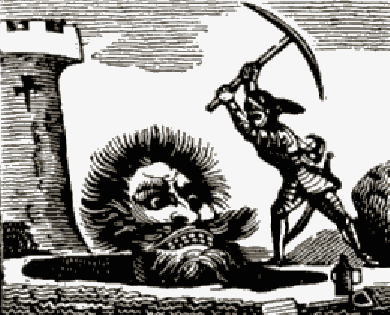
The Giant of St. Michael’s Mount: The Cornish legend of Jack the Giant Killer and St Michael’s Mount is one our islanders know well. It is said that the Mount was built as a home by the giant Cormoran and his wife, Cormelian, who were said to have lived in a mighty forest, now submerged beneath Mounts Bay. They quarried the finest white granite from which the island was formed and Cormelian was forced by her husband to carry the stones in her apron. One day, when he fell asleep, she decided to carry the lighter greenstone instead, but he awoke and caught her. Enraged, he kicked her, her apron strings broke and she dropped the greenstone which buried itself deep in the sand. However, a piece of it is still to be seen on the causeway leading to the Mount and is now known as Chapel Rock.
As well as being a very bad husband (!), Cormoran was also a troublemaker, who terrorised the land, stealing cattle whenever his tummy began to rumble. Only Jack, a young lad from Marazion – the town peering back at the Mount from the mainland – was brave enough to rid the town of its curse. It’s said that one moonlit night, he made his way across the cobbled causeway to lay a trap, before luring the monster out with a blast on his horn. The enraged Cormoran rushed down from the Mount and, before he could reach Jack, fell into the disguised pit. Jack then struck the giant a mortal blow with his pick and filled the pit with earth. The people of Cornwall were delighted and, as a gift to his bravery, he was presented with a sword engraved with his name. Jack became known as Jack the Giant Killer, a name of legends……
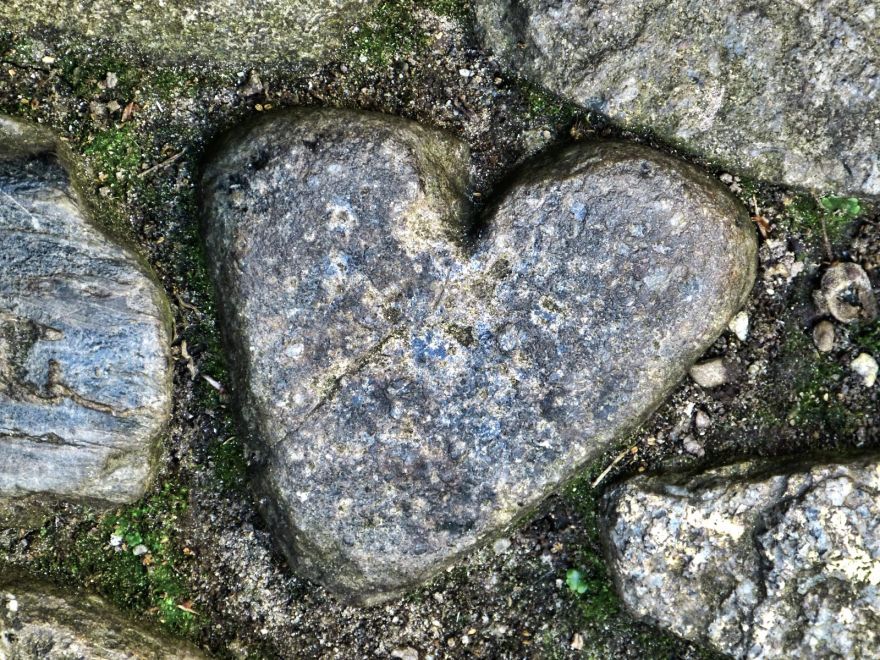
But, some locals will tell you that, even today,Cormoran isn’t truly gone! Set in the cobbled path, leading up to the castle on St Michael’s Mount is a heart-shaped rock, said to be Comoran’s stone heart….. and, if you put your ear near enough to the heart stone, you may still hear the giant’s heartbeat…..
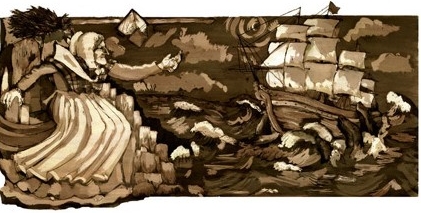
Madgy Figgy’s Chair: A little way beyond Porthcurno lies another fishing hamlet, named Porthgwarra, which, one may well suspect, has a history of more incidents than naturally arise from nets and trawls. A short climb above this cluster of dwellings brings us out on the summit of Tol-Pedn-Pennwydh (or Gwennap Head, in modern vernacular). There is no grander sight in Western Cornwall than the sheer dropping of this mighty headland to the sea. Its dark jutting shoulders and the huge buttresses still impress the mind today, as they surely did in olden times, when every peak along these coasts had tale of witches gathering to watch and help the growing storms, or sailing through the air on stalks of ragwort. On the top of Tol-Pedn is a rude recess among the cubes of granite, which keeps the name of Madgy Figgy’s Chair.
Madgy Figgy was accounted one of the blackest of all the Penwith witches and from her Chair she could look out over the ships navigating the treacherous waters around the Runnel Stone….and not just watch! It is said that, often, when the winter storms were rising and the seamanship skills of the great ships was being put to the test, she would be seen swinging to and fro with exultation in her chair, screaming out her incantations until the storm rose into ungovernable fury, and drew the vessels nearer and nearer to the reefs. Then when the crash was imminent, Madgy Figgy would sail off from her chair on a stalk of ragwort and float, shrieking up and down in the air, while far below her, the wreckers stripped the bodies cast ashore and gathered up the wrecks’ cargo.
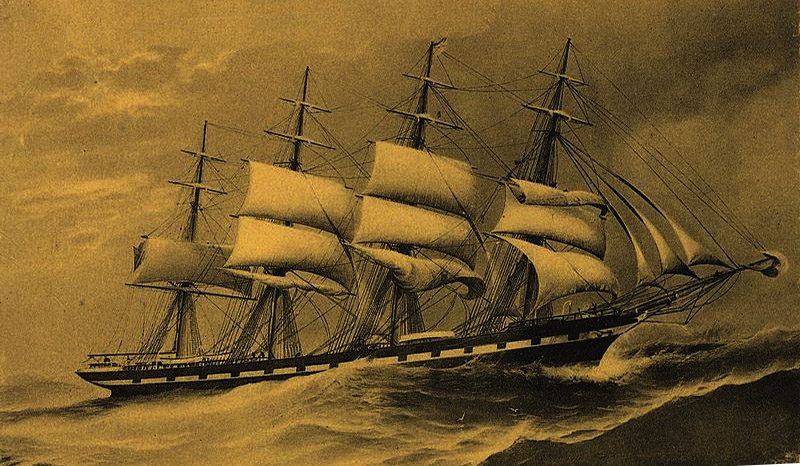
The Ghost Ship of Porthcurno: Porthcurno Cove is situated a little to the west of the Logan Stone. There, as in nearly all the coves around this coast, once existed a small chapel or oratory, dedicated to St Leven. However, nowadays, a small square enclosure is all that remains of this little holy place. The valley is, in every respect, a melancholy spot and, at night, or during a period of storms, is exactly the sort of place which might well be haunted by demon revellers. Indeed, few locals care to cross that valley after nightfall in case they encountered the Ghost Ship of Porthcurno. This strange apparition is said to have been observed frequently, coming in from sea at nightfall, when the mists were rising from the marshy ground in the Bottoms. A ghostly, black, square-rigged four-masted sailing ship, hatches all battened down, would sail into the bay. But the dark spectral form would not stop at the sand…. instead, it would continue up the beach, and inland as far as St Levan, where it would disappear within sight of the church, vanishing like smoke. No crew would ever be witnessed, not even rowing the small boat which sometimes followed!
For those who saw the ghost ship, misfortune was always said to follow….
This ghostly vessel was believed to be somehow connected with a sinister man who returned from sea, and lived in the village many, many years ago. He was always followed by his equally sinister and strange servant, of forbidding aspect, who continued to be his only attendant. This servant was never known to speak to any one save his master, and nobody in the village knew who they were, or ever talked to them. They kept a boat at Porthcurno Cove and, at daylight, would start for sea, never returning until night (not infrequently, remaining out the whole night, especially if the weather was tempestuous). Their only other pastime was hunting. It mattered not to them whether it was day or night; when the storm was at its loudest, this strange man would be out and about, accompanied by his servant (the devil?), and the midnight cry of his dogs would disturb the countryside.
This mysterious being eventually died and then the servant sought the aid of a few locals, to bear his coffin to the churchyard. The corpse was laid in the grave, around which the dogs were gathered, with the foreigner in their midst. As soon as the earth was thrown on the coffin, man and dogs disappeared, and – strange to say – at the same moment, the boat disappeared from the cove! It has never been seen since and, from that day to this, no one has been able to keep a boat in Porthcurno Cove…..
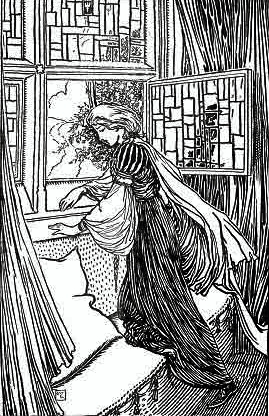
Sweet William and Fair Nancy: Nancy was the daughter of a rich farmer who did not consider William, her suitor, was good enough for his daughter. He tried to stop them seeing each other. However the pair continued to meet in secret & promised each other that one day they would marry. In due course William was called back to sea. The months passed by with no word from William but Nancy stayed true to him. She spent hours gazing out to sea at Hella Point (the headland to the west of Porthgwarra’s cove) which became known as ‘Nancy’s Garden’. As time passed, having no word from him, Nancy began to slowly go mad. One evening she thought she heard her loved one tapping at her window, beckoning her to join him at sea. She rushed to Porthgwarra’s cove (later, for obvious reasons, called Sweethearts Cove)….and was never seen again! William appeared to his father that same night, telling him he had come back for his bride and bidding his father farewell. The next day, news came of William’s death ……. by drowning, thousands of miles away. Locally, it is said that, on certain nights, when the tide lashes at the rocks of Porthgwarra Cove you can, if you are lucky, still see the ghostly couple, huddled together, braving the winds in their quest for endless love
Madgy Figgy Artwork courtesy of Tamsyn “GurdyBird” Swingler @ Tarraway Hoofpress
